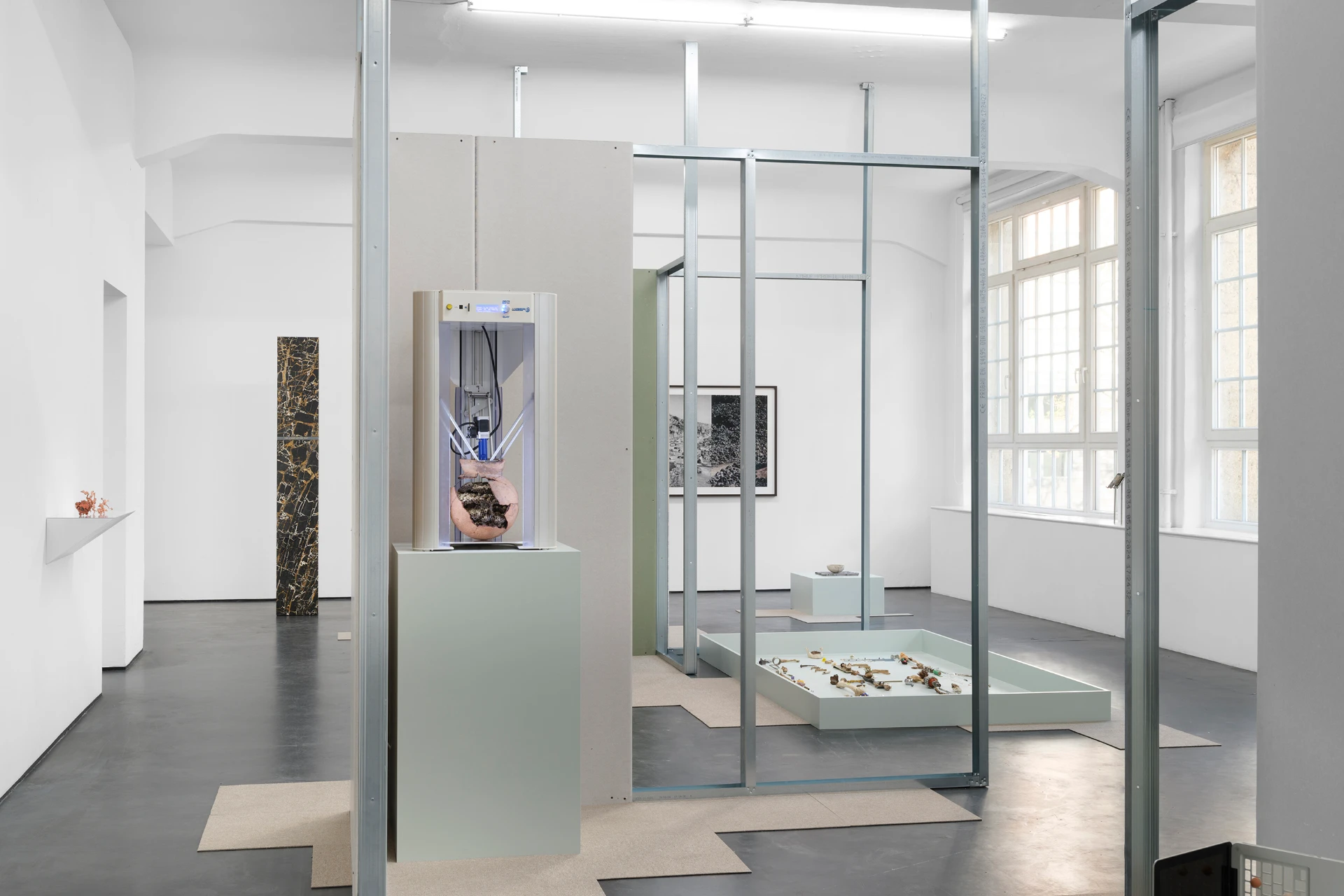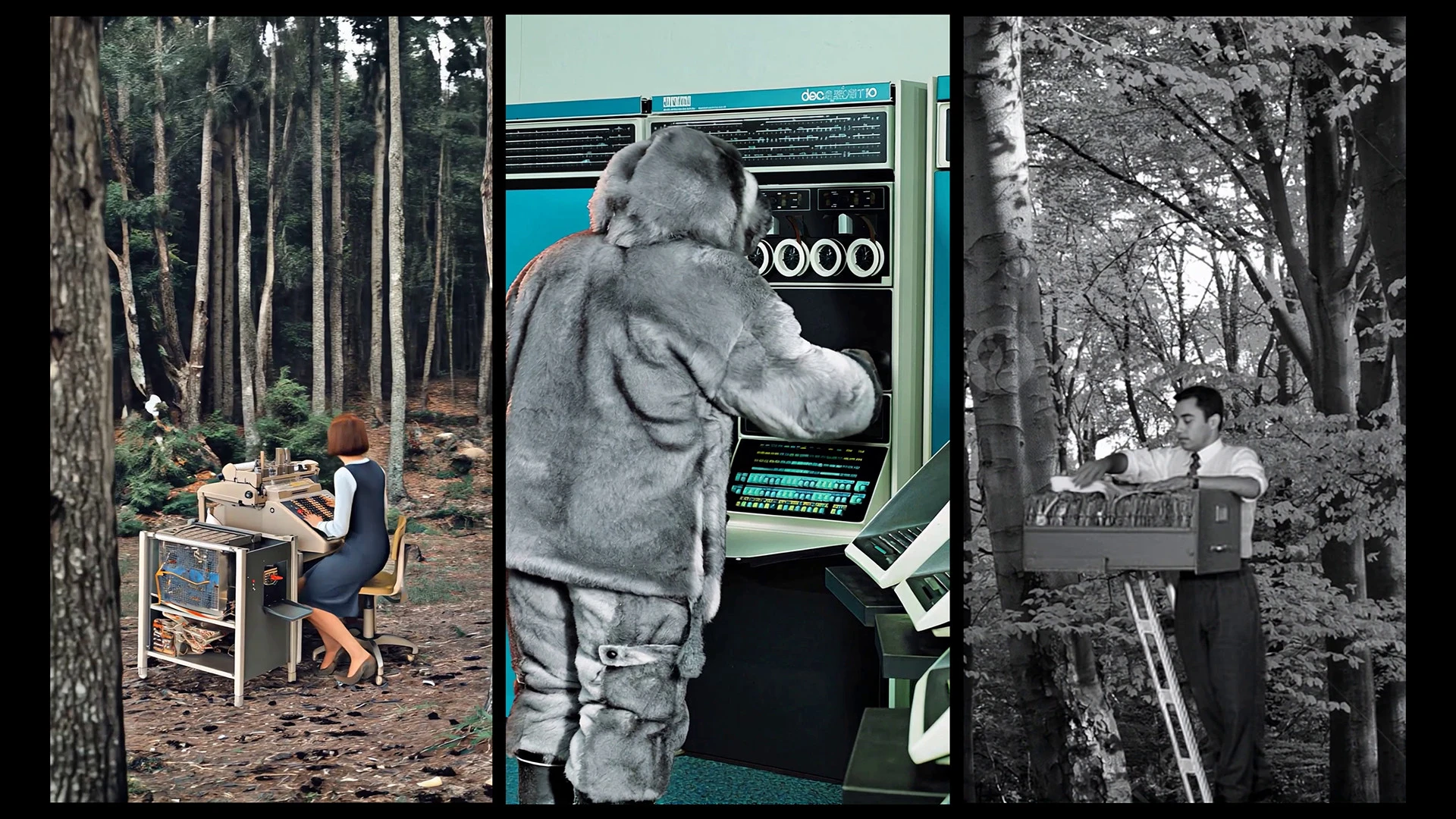Amaris Navarro (b. 1991), based in Zurich and St. Gallen, builds his practice on the linguistic logic of algorithms, teasing out their mystical residues. At Kunst Halle Sankt Gallen, Navarro treats algorithms not merely as tools or threats, but as cultural artefacts—reflecting how we shape them, and how they shape our deepest beliefs. He investigates the parallels between code and prayer, prompts and spells, neural networks and divination rituals. Language, in his hands, becomes mutable, sacred, and strange. Letters morph into holy sigils, script becomes sculpture, and fragments of digital logic become poetic structures. This interview with Navarro delves deeper into the philosophical and material dimensions of his work. What does it mean to place faith in systems we can’t fully grasp? How are language models reconfiguring our relationship to meaning, power, and even the sacred? While speaking with Navarro, we entered a space where belief is not banished by technology, but reborn through it—half prophecy, half glitch.
Alexander Burenkov: The exhibition title, ‘algorithmic-mega-death-superspell.exe’ is as provocative as it is cryptic. What does this combination of terms suggest about the role of algorithms in our contemporary belief systems?
Aramis Navarro: Algorithms shape our behaviour—whether that happens consciously or not is irrelevant to me in this context. Like commandments or dogmas, they carry a normative power that subtly directs decision-making and action. The term "mega-death" refers to a fictional superlative: a kind of symbolic death of autonomy, perhaps even the quiet fading of individuality. The ".exe" extension interests me as a nod to executable programs—the idea that an exhibition could function like a file that runs on its own when entered. Ideally, something is installed in the viewer: a new line of thinking, a moment of disorientation, a glitch in the system – that would be a success!
AB: Post-digital culture often blurs the boundaries between the mystical and the technological. How do you see magic and algorithms converging in your work?
AN: I'm drawn to this juxtaposition because what seems old or familiar can often offer a sharper, more precise lens on the present. The collision between magic and algorithmic systems has shown me that these seemingly unrelated domains share more than one might expect. What fascinates me most is how language functions in both contexts—not merely as a tool for communication or semantics, but as an operative force. It becomes function, code, command. An additional layer that acts beyond what is said.
AB: In ‘Defixio’, you reimagine ancient curse tablets as plates cast in aluminum—the metal of the digital age—inscribed with invented Python code, drawing on the millennia-old custom of curse tablets: inscriptions carved into thin sheets of lead, buried near graves or temples, intended to bewitch people. You transfer these occult practices to aluminium plates, into which you incise fragments of fictitious algorithms. What draws you to this overlap between ancient magic rituals, notions of the sacred, and contemporary syntax of digital technologies?
AN: I'm interested in forms of language that are tied to desire, intention, and function. From a metaphysical perspective, I find the parallel between pagan practices like cursing and the algorithms that permeate and influence us online surprisingly close. It’s not unlike a voodoo ritual—using a proxy to exert influence from a distance, detached from space or time. A similar logic operates in today’s tech centers, such as Silicon Valley. The mechanisms are comparable: invisible language that wants to act.
AB: You describe language as both material and method in your practice. Could you elaborate on how you navigate this dual role of language—particularly in works like Inflected Introspection, where your typed reflections—daily thoughts, concepts, and observations—are archived on recycled studio paper and then preserved in resin, echoing the logic of amber fossils?
AN: When I use language as material, I approach it much like a writer or a poet—it becomes substance. As a method, it can serve as a conceptual tool, a framework, or a way of structuring thought. I'm interested in different dimensions of language, perhaps most of all its visual and metaphorical potential. In Inflected Introspection, this becomes very clear. I don’t distinguish what ends up typed on the paper—it’s about archiving handwritten notes without hierarchy. Sometimes the content is poetic, sometimes philosophical, technical, or simply descriptive. What interests me are the loopholes—moments where language slips, bends, or opens up another way of seeing communication itself. I only preserve these notes in resin once they’ve served their purpose in the development of further ideas or works.
AB: Much of your work seems to revolve around preservation—be it language fossilized in resin or scripts etched into metal. What does preservation mean to you in a time of digital ephemerality and constant algorithmic churn?
AN: Preservation, for me, means potential—the chance for something to be read differently in another context. Holding on to a fragment doesn’t mean closing it off; it creates the possibility of re-encountering. Especially in a time where content is hyper-ephemeral, constantly reshuffled or erased by algorithms, I’m interested in what it means to materially inscribe something. Whether it’s notes fossilized in resin or algorithms engraved in metal, the act is about freezing time and meaning—so that it might surface again, with new relevance.
AB: Do you see language models like ChatGPT as collaborators, tools, or something more ambiguous in your creative process?
AN: For me, it’s clearly a tool—but also a harbinger. Language models aren’t just functional aids; they’re phenomena that reflect something about the present moment. In how they operate, they mirror collective pasts, patterns of thought, and ideologies. They’re both instrument and omen—a technical device already casting the supposedly shadow of what’s to come.
AB: Your practice often involves analog processes—such as typewriting on recycled paper—even while grappling with digital themes. How does this analog-digital tension shape your thinking?
AN: It came about quite naturally—partly out of necessity. It’s simply how I work, what I’m drawn to. The space between analog and digital isn’t a contradiction to me; it’s an incredibly fertile ground. It creates friction, uncertainty, detours—and that’s exactly where things start to get interesting.
AB: The term “oracle” recurs in your exhibition text. How do you view algorithms as oracular systems, and what kind of truths—or illusions—do they offer us?
AN: If we focus on text generators—based on large language models—they’re essentially fortune tellers. Depending on the data, these same systems could be used to predict all sorts of things. Humans have always wanted to see into the future, some more than others—or at least to see a bit further than their neighbor. Weather forecasts used to feel special, now everyone has access. But if I could predict the weather exactly one year from now—that would be a form of power. I do believe LLMs (large language models) will increasingly be used for forecasting across many fields. The more pressing question is whether they’ll serve the common good.
AB: ‘Algorithmic Overlord’ explores how digital systems shape perception, interaction, and decision-making. The series focuses on the role of language and code in everyday life, highlighting how algorithms influence human behavior in subtle ways. With this project, you address the subtle ways code shapes behavior. How do you approach making these invisible structures visible without becoming overly didactic?
AN: I try not to leave humour out of the equation. Through language, I aim to sketch a picture in the viewer’s mind—one that might open a new perspective. It doesn’t always work the same way, but that unpredictability is part of the appeal. It leaves space for interpretation.
AB: Mirror surfaces and display-like forms transformed into display-like altar pieces appear in works like Ratking’s hyper-sanctum. Can you speak about how you use visual language to evoke digital environments and interfaces as spaces of reverence or ritual?
AN: It’s quite simple. I merge two seemingly unrelated elements, in this case, the aesthetics of mirror surfaces and screen-like forms with altar pieces. Within this connection, a new statement is established, one inseparable from our current reality. Each element carries its own associations, but it’s precisely in their fusion that something new emerges, making digital environments visible as spaces of reverence or ritual.
AB: There’s a palpable undercurrent of faith, superstition, and mysticism in your show. Do you think technology has replaced religion in today’s cultural psyche—or has it merely become another form of it?
AN: I’m still exploring this question myself. Sometimes, I think technology takes on a new form—one that is less dogmatic and structured by different hierarchies. At other times, it adopts familiar, older forms. From this perspective, our current era is incredibly fascinating, as these questions become increasingly urgent. I also see a widespread disappointment: the promises of digitality and their consequences unsettle many people. And uncertainty, ultimately, has always driven human behaviour.
AB: You describe some of your code-like fragments as “silent commands”—language without exchange. How do you interpret this muteness, and what does it say about agency in a system-driven world?
AN: I understand these "silent commands" as language without an opponent—no feedback, no back-and-forth. They work in a one-way mode, but still do their job because they’re part of a system built for effect, not real communication. This silence shows a new kind of agency: action doesn’t need to be conscious or interactive anymore, it’s automated and coded. That opens up big questions about control and responsibility in a world increasingly run by systems.
AB: Finally, what does “believing in our devices” mean to you personally? And how do you think your art might reshape or complicate that belief for your audience?
AB: I believe that merely questioning the role and function of our devices today would have been enough to get someone burned at the stake in another era. The context—or perspective—from which something is viewed is crucial. It’s also interesting how well the term “belief” fits here. Perhaps these devices are gatekeepers for an evolution still ahead of us—emotional, cognitive, or maybe even biological—simply through the presence of something more intelligent, regardless of whether we choose to believe in it or not.

